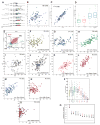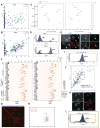Single-cell analysis reveals that expression of nanog is biallelic and equally variable as that of other pluripotency factors in mouse ESCs
- PMID: 23827708
- PMCID: PMC4035816
- DOI: 10.1016/j.stem.2013.04.019
Single-cell analysis reveals that expression of nanog is biallelic and equally variable as that of other pluripotency factors in mouse ESCs
Abstract
The homeodomain transcription factor Nanog is a central part of the core pluripotency transcriptional network and plays a critical role in embryonic stem cell (ESC) self-renewal. Several reports have suggested that Nanog expression is allelically regulated and that transient downregulation of Nanog in a subset of pluripotent cells predisposes them toward differentiation. Using single-cell gene expression analyses combined with different reporters for the two alleles of Nanog, we show that Nanog is biallelically expressed in ESCs independently of culture condition. We also show that the overall variation in endogenous Nanog expression in ESCs is very similar to that of several other pluripotency markers. Our analysis suggests that reporter-based studies of gene expression in pluripotent cells can be significantly influenced by the gene-targeting strategy and genetic background employed.
Copyright © 2013 Elsevier Inc. All rights reserved.
Figures


Comment in
-
Nanog heterogeneity: tilting at windmills?Cell Stem Cell. 2013 Jul 3;13(1):6-7. doi: 10.1016/j.stem.2013.06.016. Cell Stem Cell. 2013. PMID: 23827703 Free PMC article.
References
-
- Chambers I, Colby D, Robertson M, Nichols J, Lee S, Tweedie S, Smith A. Functional expression cloning of Nanog, a pluripotency sustaining factor in embryonic stem cells. Cell. 2003;113:643–655. - PubMed
-
- Chambers I, Silva J, Colby D, Nichols J, Nijmeijer B, Robertson M, Vrana J, Jones K, Grotewold L, Smith A. Nanog safeguards pluripotency and mediates germline development. Nature. 2007;450:1230–1234. - PubMed
-
- Filipczyk A, Gkatzis K, Fu J, Hoppe P, Lickert H, Anastassiadis K, Schroeder T. Biallelic expression of Nanog protein in mouse embryonic stem cells. Cell Stem Cell 2013 - PubMed
MeSH terms
Substances
Grants and funding
LinkOut - more resources
Full Text Sources
Other Literature Sources
Molecular Biology Databases
Research Materials

